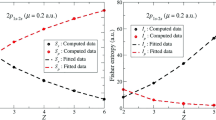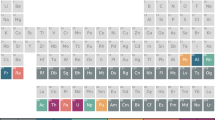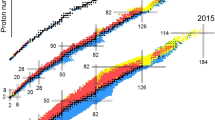Abstract
The breakup of a molecule following a fast collision with an atom in gas phase can be understood as resulting from two steps. In the first step, the atom transfers energy to the molecule, which is thus electronically and vibrationally excited. In the second step, the molecule decays leading to different fragments, while the initial charge, energy, and angular momentum are conserved. Here, we demonstrate that, by maximizing the entropy of the system under these conservation laws, it is possible to reproduce the fragmentation yields resulting from collision experiments. In particular, our model is applied to investigate fragmentation of excited neutral and singly charged carbon clusters and mono-hydrogenated carbon clusters. These species are commonly exposed to energetic ionizing radiation in the interstellar medium, so understanding the key aspects of their fragmentation, in particular the way energy and charge are shared in the process, can be relevant to get a deeper insight on the evolution of carbonaceous species in the universe.






Similar content being viewed by others
References
Agúndez M, Wakelam V (2013) Chemistry of dark clouds: Databases, networks, and models. Chem Rev 113(12):8710. https://doi.org/10.1021/cr4001176 PMID: 24099569
Brünken S, Kluge L, Stoffels A, Asvany O, Schlemmer S (2014) Laboratory Rotational Spectrum of \(l-{\rm C}_3H^+\) and Confirmation of its Astronomical Detection. Astrophys J Lett 783(1):L4 http://stacks.iop.org/2041-8205/783/i=1/a=L4
Maciel WJ (2013) Astrophysics of the interstellar medium. Springer, Berlin. https://doi.org/10.1007/978-1-4614-3767-3
Yamada KMT, Winnewisser G (eds.), Interstellar Molecules (Springer, 2011). https://doi.org/10.1007/978-3-642-16268-8
Wakelam V, Herbst E, Loison JC, Smith IWM, Chandrasekaran V, Pavone B, Adams NG, Bacchus-Montabonel MC, Bergeat A, Béroff K, Bierbaum VM, Chabot M, Dalgarno A, van Dishoeck EF, Faure A, Geppert WD, Gerlich D, Galli D, Hébrard E, Hersant F, Hickson KM, Honvault P, Klippenstein SJ, Picard SL, Nyman G, Pernot P, Schlemmer S, Selsis F, Sims IR, Talbi D, Tennyson J, Troe J, Wester R, Wiesenfeld L (2012) A kinetic database for astrochemistry (kida). Astrophys. J. Suppl. S. 199(1):21 http://stacks.iop.org/0067-0049/199/i=1/a=21
Ullrich J, Shevelko V (eds.), Many-Particle Quantum Dynamics in Atomic and Molecular Fragmentation (Springer, Berlin, Heidelberg, 2003). https://doi.org/10.1007/978-3-662-08492-2
Whelan CT (ed.), Fragmentation Processes: Topics in Atomic and Molecular Physics (Cambridge University Press, 2012). https://doi.org/10.1017/CBO9781139017572
Collins MA, Bettens RPA (2015) Energy-based molecular fragmentation methods. Chem Rev 115:5607. https://doi.org/10.1021/cr500455b
Martinet G, Díaz-Tendero S, Chabot M, Wohrer K, Negra SD, Mezdari F, Hamrita H, Désesquelles P, Padellec AL, Gardés D, Lavergne L, Lalu G, Grave X, Clavelin JF, Hervieux PA, Alcamí M, Martín F (2004) Fragmentation of highly excited small neutral carbon clusters. Phys. Rev. Lett. 93:063401. 10.1103/PhysRevLett.93.063401. http://link.aps.org/doi/10.1103/PhysRevLett.93.063401
Tuna T, Chabot M, Pino T, Désesquelles P, LePadellec A, Martinet G, Barat M, Lucas B, Mezdari F, Montagnon L, Van-Oanh NT, Lavergne L, Lachaize A, Carpentier Y, Béroff K (2008) Fragmentation branching ratios of highly excited hydrocarbon molecules C\(_n\)H and their cations \({\rm C}_n{\rm H}^+\) (n\(\le \)4). J. Chem. Phys. 128(12):124312. 10.1063/1.2884862. http://dx.doi.org/10.1063/1.2884862
Chabot M, éroff KB, Gratier P, Jallat A, Wakelam V (2013) Reactions Forming \({\rm C}_{n=2, 10}^{(0,+)}\), \({\rm C}_{n=2,4}{\rm H}^{(0, +)}\), and \({\rm C}_3{\rm H}_2^{(0, +)}\) in the Gas Phase: Semiempirical Branching Ratios, Astrophys. J. 771(2), 90. http://stacks.iop.org/0004-637X/771/i=2/a=90
Chabot M, Fossé R, Wohrer K, Gardès D, Maynard G, Rabilloud F, Spiegelman F (2001) Multi-ionization cross-sections of small ionic carbon clusters by particle impact as a tool to investigate their shapes. Eur Phys J D 14(1):5. https://doi.org/10.1007/s100530170226
Reinhard P, Suraud E (2008) Introduction to cluster dynamics. Wiley, New York. https://doi.org/10.1002/9783527602520
Vincendon M, Suraud E, Reinhard P (2017) Dissipation and energy balance in electronic dynamics of na clusters. Eur Phys J D 71:179. https://doi.org/10.1140/epjd/e2017-80067-0
Wang ZP, Dinh PM, Reinhard PG, Suraud E (2014) Ultrafast nonadiabatic dynamics of a water dimer in femtosecond laser pulses. Laser Phys 24(10):106004. https://doi.org/10.1088/1054-660x/24/10/106004
Hansen K (2018) Statistical Physics of Nanoparticles in the Gas Phase, Springer Series on Atomic, Optical, and Plasma Physics, vol. 73 (Springer, Cham). https://doi.org/10.1007/978-3-319-90062-9
Hansen K, Näher U (1999) Evaporation and cluster abundance spectra. Phys Rev A 60(2):1240. https://doi.org/10.1103/PhysRevA.60.1240
Calvo F, Galindez J, Gadéa FX (2003) Internal conversion in the photofragmentation of \({\rm Ar}_n^+\) clusters (\(n = 38\)). Phys Chem Chem Phys 5(2):321. https://doi.org/10.1039/B210796C
Calvo F, Berthias F, Feketeová L, Abdoul-Carime H, Farizon B, Farizon M (2017) Collision-induced evaporation of water clusters and contribution of momentum transfer. Eur Phys J D 71(5):110. https://doi.org/10.1140/epjd/e2017-80062-5
Abdoul-Carime H, Berthias F, Feketeová L, Marciante M, Calvo F, Forquet V, Chermette H, Farizon B, Farizon M, Märk TD (2015) Velocity of a Molecule Evaporated from a Water Nanodroplet: Maxwell-Boltzmann Statistics versus Non-Ergodic Events. Angew Chem Int Ed 54(49):14685. https://doi.org/10.1002/anie.201505890
Berthias F, Buridon V, Abdoul-Carime H, Farizon B, Farizon M, Dinh PM, Reinhard PG, Suraud E, Märk TD (2014) Collision-induced dissociation of protonated water clusters. Phys Rev A 89:062705. https://doi.org/10.1103/PhysRevA.89.062705
Hervieux PA, Gross DHE (1995) Evaporation of hot mesoscopic atomic metal clusters. Z Phys D - Atoms, Molecules Clusters 33:295–299. https://doi.org/10.1007/BF01437510
Gross DHE, Hervieux PA (1995) Statistical fragmentation of hot atomic metal clusters. Z Phys D - Atoms, Molecules Clusters 35:27–42. https://doi.org/10.1007/BF01439980
Hervieux PA, Zarour B, Hanssen J, Politis MF, Martín F (2001) Fragmentation in collisions of Na\(_9^+\) clusters with Cs atoms. J Phys B: Atom Mol Opt Phys 34(16):3331. https://doi.org/10.1088/0953-4075/34/16/310
Bréchignac C, Cahuzac P, Concina B, Leygnier J, Ruiz LF, Zarour B, Hervieux PA, Hanssen J, Politis MF, Martín F (2002) Charge transfer and dissociation in collisions of metal clusters with atoms. Phys Rev Lett 89:183402. https://doi.org/10.1103/PhysRevLett.89.183402
Calvo F, Spiegelman F (2004) On the premelting features in sodium clusters. J Chem Phys 120(20):9684. https://doi.org/10.1063/1.1714792
Díaz-Tendero S, Ruiz LF, Zarour B, Calvo F, Spiegelman F, Hervieux P-A, Martín F, Hanssen J, Politis MF (2007) Fragmentation induced by charge exchange in collisions of charged alkaline clusters with alkali atoms. Eur Phys J D 44(3):525. https://doi.org/10.1140/epjd/e2007-00216-4
Martinet G, Chabot M, Wohrer K, Della Negra S, Gardés D, Scarpaci JA, Désesquelles P, Lima V, Díaz-Tendero S, Alcamí M, Hervieux P-A, Politis MF, Hanssen J, Martín F (2003) Fragmentation of neutral C\(_n\) clusters (\(n<9\)): experimental and theoretical investigations. Eur Phys J D 24(1–3):149. https://doi.org/10.1140/epjd/e2003-00102-1
Díaz-Tendero S, Hervieux PA, Alcamí M, Martín F (2005) Statistical fragmentation of small neutral carbon clusters. Phys Rev A 71:033202. https://doi.org/10.1103/PhysRevA.71.033202
Díaz-Tendero S, Sánchez G, Hervieux PA, Alcamí M, Martín F (2006) Ionization potentials, dissociation energies and statistical fragmentation of neutral and positively charged small carbon clusters. Braz J Phys 36:529
Daz-Tendero S, Snchez G, Alcam M, Martn F, Hervieux PA, Chabot M, Martinet G, Dsesquelles P, Mezdari F, Wohrer-Broff K, Negra SD, Hamrita H, LePadellec A, Montagnon L (2006) Fragmentation of small neutral carbon clusters. Int J Mass Spectrom 252(2):126. https://doi.org/10.1016/j.ijms.2005.12.055 Special Issue on Cluster Cooling
Calvo F, Parneix P (2006) Statistical dissociation of small carbon clusters: A phase space theory investigation. Comput Mater Sci 35(3):198. https://doi.org/10.1016/j.commatsci.2004.07.007
Montagnon L, Spiegelman F (2007) Self-consistent field tight-binding model for neutral and (multi-) charged carbon clusters. J Chem Phys 127(8):084111. https://doi.org/10.1063/1.2759210
Désesquelles P, Van-Oanh NT, Thomas S, Domin D (2020) Statistical molecular fragmentation: which parameters influence the branching ratios? Phys Chem Chem Phys 22(6):3160. https://doi.org/10.1039/C9CP05095G
Aguirre NF, Díaz-Tendero S, Hervieux PA, Alcamí M, Martín F (2017) \(M3C\): a computational approach to describe statistical fragmentation of excited molecules and clusters. J Chem Theory Comput 13(3):992. https://doi.org/10.1021/acs.jctc.6b00984 PMID: 28005371
Aguirre NF, Díaz-Tendero S, IdBarkach T, Chabot M, Béroff K, Alcamí M, Martín F (2019) Fully versus constrained statistical fragmentation of carbon clusters and their heteronuclear derivatives. J Chem Phys 150(14):144301. https://doi.org/10.1063/1.5083864
Chabot M, Mezdari F, Béroff K, Martinet G, Hervieux PA (2010) Scaling law for the partitioning of energy in fragmenting multicharged carbon clusters. Phys Rev Lett 104:043401. https://doi.org/10.1103/PhysRevLett.104.043401
Díaz-Tendero S, Martín F (2002) Structure, dissociation energies, and harmonic frequencies of small doubly charged carbon clusters C\(_n^{2+}\) (\(n = 3--9\)). J Phys Chem A 106(45):10782. https://doi.org/10.1021/jp0257956
Sánchez JP, Aguirre NF, Díaz-Tendero S, Martín F, Alcamí M (2016) Structure, ionization, and fragmentation of neutral and positively charged hydrogenated carbon clusters: C\(_n\)H\(_m^q+\) (\(n = 1--5\), \(m = 1--4\), \(q = 0--3\)). J Phys Chem A 120(4):588. https://doi.org/10.1021/acs.jpca.5b10143 PMID: 26683517
Frisch MJ, Trucks GW, Schlegel HB, Scuseria GE, Robb MA, Cheeseman JR, Scalmani G, Barone V, Mennucci B, Petersson GA, Nakatsuji H, Caricato M, Li X, Hratchian HP, Izmaylov AF, Bloino J, Zheng G, Sonnenberg JL, Hada M, Ehara M, Toyota K, Fukuda R, Hasegawa J, Ishida M, Nakajima T, Honda Y, Kitao O, Nakai H, Vreven T, Montgomery JA Jr, Peralta JE, Ogliaro F, Bearpark M, Heyd JJ, Brothers E, Kudin KN, Staroverov VN, Kobayashi R, Normand J, Raghavachari K, Rendell A, Burant JC, Iyengar SS, Tomasi J, Cossi M, Rega N, Millam JM, Klene M, Knox JE, Cross JB, Bakken V, Adamo C, Jaramillo J, Gomperts R, Stratmann RE, Yazyev O, Austin AJ, Cammi R, Pomelli C, Ochterski JW, Martin RL, Morokuma K, Zakrzewski VG, Voth GA, Salvador P, Dannenberg JJ, Dapprich S, Daniels AD, Farkas Ö, Foresman JB, Ortiz JV, Cioslowski J, Fox DJ (2010) Gaussian 09 Revision B.01
Chen L, Martin S, Bernard J, Brédy R (2007) Direct measurement of internal energy of fragmented \({\rm c}_{60}\). Phys Rev Lett 98:193401. https://doi.org/10.1103/PhysRevLett.98.193401
Maclot S, Delaunay R, Piekarski DG, Domaracka A, Huber BA, Adoui L, Martín F, Alcamí M, Avaldi L, Bolognesi P, Díaz-Tendero S, Rousseau P (2016) Determination of energy-transfer distributions in ionizing ion-molecule collisions. Phys Rev Lett 117:073201. https://doi.org/10.1103/PhysRevLett.117.073201
Labaigt G, Jorge A, Illescas C, Béroff K, Dubois A, Pons B, Chabot M (2015) Electron capture and ionization processes in high-velocity C\(_n^+\), CAr and C\(_n^+\), CHe collisions. J Phys B: Atom, Mol Opt Phys 48(7):075201. https://doi.org/10.1088/0953-4075/48/7/075201
Grimme S (2013) Towards first principles calculation of electron impact mass spectra of molecules. Angew Chem Int Ed 52(24):6306. https://doi.org/10.1002/anie.201300158
Bauer CA, Grimme S (2014) Elucidation of electron ionization induced fragmentations of adenine by semiempirical and density functional molecular dynamics. J Phys Chem A 118(49):11479. https://doi.org/10.1021/jp5096618
Bauer CA, Grimme S (2016) How to compute electron ionization mass spectra from first principles. J Phys Chem A 120(21):3755. https://doi.org/10.1021/acs.jpca.6b02907
Ásgeirsson V, Bauer CA, Grimme S (2017) Quantum chemical calculation of electron ionization mass spectra for general organic and inorganic molecules. Chem Sci 8(7):4879. https://doi.org/10.1039/C7SC00601B
de Hoffmann E, Stroobant V (2007) Mass spectrometry: principles and applications, 3rd edn. Wiley, New York
Gross JH (2017) Fragmentation of organic ions and interpretation of EI mass spectra. Springer International Publishing, Cham, pp 325–437
Nicolas C, Shu J, Peterka DS, Hochlaf M, Poisson L, Leone SR, Ahmed M (2006) Vacuum ultraviolet photoionization of C\(_3\). J Am Chem Soc 128(1):220. https://doi.org/10.1021/ja055430 PMID: 16390150
Jallat A (2015) Fragmentation de molécules carbonées d’intérêt astrophysique auprès des accélérateurs. Ph.D. thesis, Université Paris-11
Misakian M, Zorn JC (1972) Dissociative excitation of molecular hydrogen by electron impact. Phys Rev A 6(6):2180. https://doi.org/10.1103/PhysRevA.6.2180
Brouillard F et al (1986) Atomic processes in electron-ion and ion-ion collisions. Springer, Boston, MA. https://doi.org/10.1007/978-1-4684-5224-2
Belki D (2012) Fast ion-atom and ion-molecule collisions. World Scientific, Singapore. https://doi.org/10.1142/8485
Calvo F, Díaz-Tendero S, Lebeault MA (2009) Translational, rotational and vibrational energy partitioning in the sequential loss of carbon dimers from fullerenes. Phys Chem Chem Phys 11:6345. https://doi.org/10.1039/B901557D
Rentenier A, Ruiz LF, Díaz-Tendero S, Zarour B, Moretto-Capelle P, Bordenave-Montesquieu D, Bordenave-Montesquieu A, Hervieux PA, Alcamí M, Politis MF, Hanssen J, Martín F (2008) Absolute charge transfer and fragmentation cross sections in \({\rm He}^{2+}- {\rm C}_{60}\) collisions. Phys Rev Lett 100:183401. https://doi.org/10.1103/PhysRevLett.100.183401
Díaz-Tendero S, Alcamí M, Martín F (2003) Theoretical study of ionization potentials and dissociation energies of C\(_n^{q+}\) fullerenes (\(n=50-60\), \(q=0\), 1 and 2). J Chem Phys 119(11):5545. https://doi.org/10.1063/1.1597634
Tomita S, Andersen JU, Gottrup C, Hvelplund P, Pedersen UV (2001) Dissociation energy for \({\rm C}_{2}\) loss from Fullerene Cations in a Storage Ring. Phys Rev Lett 87:073401. https://doi.org/10.1103/PhysRevLett.87.073401
Wörgötter R, Dünser B, Scheier P, Märk TD, Foltin M, Klots CE, Laskin J, Lifshitz C (1996) Self-consistent determination of fullerene binding energies BE (\({\rm C}_n^+-{\rm C}_2\)), \(n=58,\ldots,44\). J Chem Phys 104(4):1225. https://doi.org/10.1063/1.471708
Campbell E (2003) Fullerene Collision Reactions. Developments in Fullerene Science (Springer). https://books.google.es/books?id=2ekBUHXNcRwC
Maclot S, Piekarski DG, Domaracka A, Méry A, Vizcaino V, Adoui L, Martín F, Alcamí M, Huber BA, Rousseau P, Díaz-Tendero S (2013) Dynamics of glycine dications in the gas phase:ultrafast intramolecular hydrogen migration versus coulomb repulsion. J Phys Chem Lett 4(22):3903. https://doi.org/10.1021/jz4020234
Jochim B, Lueking A, Doshier L, Carey S, Wells E, Parke E, Leonard M, Carnes KD, Ben-Itzhak I (2009) Rapid formation of \({\rm H}_3^+\) from ammonia and methane following 4 MeV proton impact. J. Phys. B At. Mol. Opt.Phys 42(9):091002 http://stacks.iop.org/0953-4075/42/i=9/a=091002
De S, Roy A, Rajput J, Ghosh P, Safvan C (2008) Dissociation of methanol by ion-impact: breakup dynamics, bond rearrangement and kinetic energy release. Int J Mass Spectrom 276(1):43. https://doi.org/10.1016/j.ijms.2008.06.021
De S, Rajput J, Roy A, Ghosh PN, Safvan CP (2008) Ion-induced dissociation dynamics of acetylene. Phys Rev A 77:022708. https://doi.org/10.1103/PhysRevA.77.022708
De S, Rajput J, Roy A, Ghosh PN, Safvan CP (2006) Formation of \({\rm H}_{3}{}^{+}\) due to intramolecular bond rearrangement in doubly charged methanol. Phys Rev Lett 97:213201. https://doi.org/10.1103/PhysRevLett.97.213201
Wohrer K, Chabot M, Fossé R, Gards D, Hervieux P, Calvayrac F, Reinhard P, Suraud E (1998) Swift cluster–atom collisions: a progress report. Nucl Instrum Methods Phys Res B 146(1):29. https://doi.org/10.1016/S0168-583X(98)00421-2
Acknowledgements
We acknowledge the generous allocation of computer time at the Centro de Computación Científica at the Universidad Autónoma de Madrid (CCC-UAM). The research was conducted in the framework of the COST action CA18212 Molecular Dynamics in the GAS phase (MD-GAS). This work was partially supported by the MICINN—Spanish Ministry of Science and Innovation—projects FIS2016-77889-R, CTQ2016-76061-P, and PID2019-110091GB-I00.
Author information
Authors and Affiliations
Corresponding authors
Additional information
Publisher's Note
Springer Nature remains neutral with regard to jurisdictional claims in published maps and institutional affiliations.
Published as part of the special collection of articles “Festschrift in honor of Fernand Spiegelmann”.
Rights and permissions
About this article
Cite this article
Aguirre, N.F., Díaz-Tendero, S., Hervieux, PA. et al. Charge and energy sharing in the fragmentation of astrophysically relevant carbon clusters. Theor Chem Acc 140, 22 (2021). https://doi.org/10.1007/s00214-020-02702-z
Received:
Accepted:
Published:
DOI: https://doi.org/10.1007/s00214-020-02702-z




